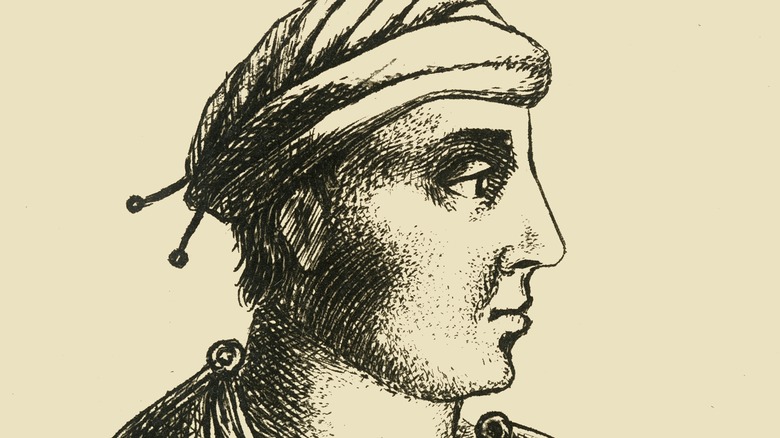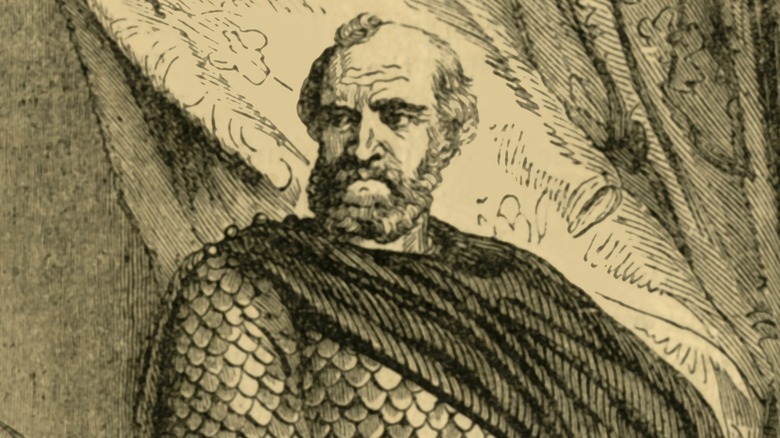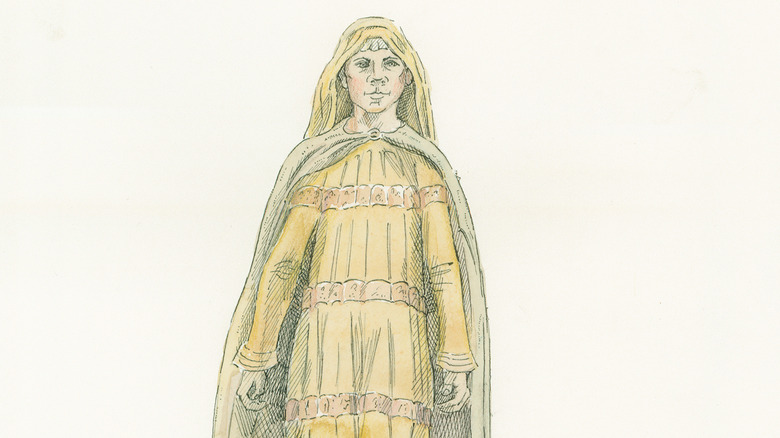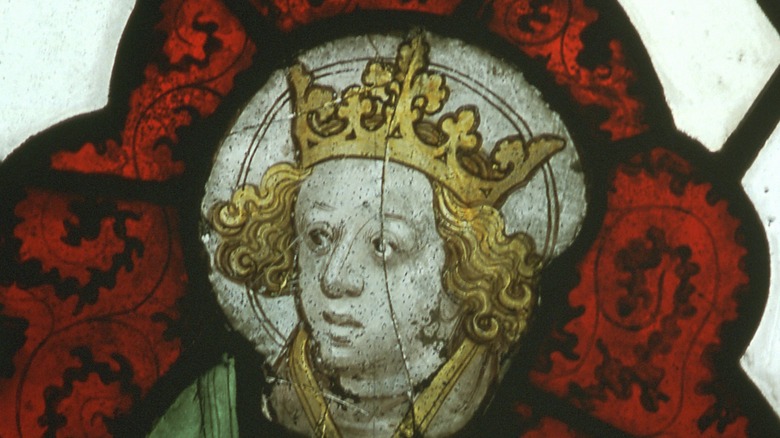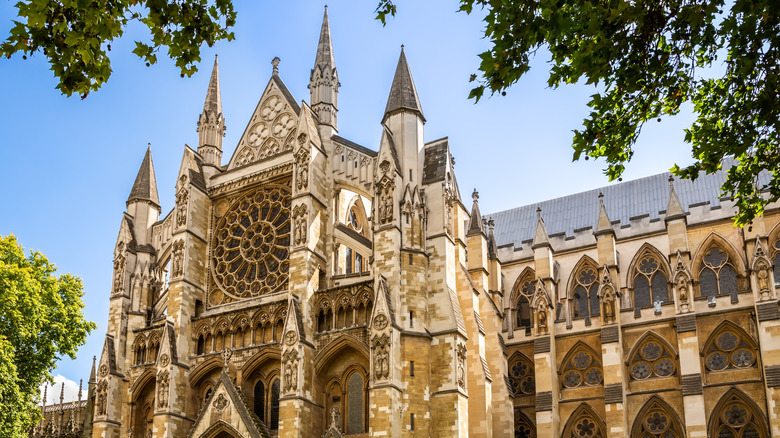Who Was The Only English King To Be Named A Saint?
Funeral services for British Queen Elizabeth II, who died at age 96, are set to take place at Westminster Abbey in London, according to The Royal Family. Though she won't be interred at Westminster, a number of Elizabeth's forbears from throughout history are entombed there, including Queen Elizabeth I, King Edward I, and King James I, among others, as the official Westminster Abbey website explains. Most notable among all the monarchs enshrined at Westminster, though, is perhaps the 11th-century English king, Edward the Confessor (pictured) the only English sovereign in history to ever become a saint (per Britannica).
To this day, misconceptions persist about what Edward was like and how he ruled. Without a doubt, though, Edward reigned over many pivotal points in history, such as the construction of an early version of Westminster Abbey in the 1040s, according to the Abbey website. (King Edward's remains were later entombed in the modern Westminster Abbey we know today). Although Edward married Edith of Wessex in his lifetime, he never produced an heir, which became a non-issue because shortly after Edward died in 1066, the Norman army invaded England to begin an era of Norman rule. It was partially for that perceived chastity, though, that Edward was later canonized.
Edward allegedly promised the crown to the Duke of Normandy
Earlier in his life, Prince Edward, the son of King Ethelred II, escaped to Normandy in the north of France during one of the many Danish invasions of his country. For this reason, Edward was seen as a sympathizer of sorts with the Norman people, who would later invade his country and take the throne. By the time Edward returned to England, his half-brother, a Dane named Hardecanute, had the crown, the last Danish king of England, as Britannica explains. Hardecanute was an unpopular king and died in 1042.
Shortly before his death, though, Hardecanute called for Edward home to England and designated him his heir. When Hardecanute died, Edward succeeded his brother on the throne, as Britannica elsewhere notes. Shortly after Edward became King he lost favor with the English people. He gave a number of Normans high-ranking positions in his court, and it's even said Edward promised the crown to William, Duke of Normandy (pictured) better known as William the Conqueror, leader of the invading Norman army.
Edward's wife, Edith, was the sister of the last Saxon king in English history
Edward the Confessor's wife, Queen Edith, was the daughter of Godwine, Duke of Essex, considered by many to be the most powerful man in England, even more so than the king. Contributing to Edward's poor reputation, his relationship with Godwine and his family was troubled. At one point, Edward fell out with Edith's father, dismissed Edith from court, and claimed the Godwine family land. As Godwine and his sons prepared to retaliate militarily against Edward militarily, Edward thought better of that decision and made amends. He welcomed Edith (pictured) and the influence of Godwine's family back at court (via Britannica).
Upon Edward's death, Edith's brother Harold II ruled England as the last Saxon king for less than one year. He was killed at the Battle of Hastings by William Duke of Normandy, the decisive battle in the Norman invasion of 1066 (per Britannica). Prior to Edward's death, and with no heir, Edward allegedly promised the throne to both Harold and William, Duke of Normandy, among other men. It was partially for this reason that William justified the Norman invasion of England. Early on, Edward was seen as a disinterested and ineffectual leader. That soon changed, though, when Harold was killed and William I took the throne.
During the reign of Edward's successors, the narrative changed
Beginning in 1066, the Normans slowly muscled their way in to rule England, and over the next couple of centuries, their influence bled over into the English language, its architecture, and established its system of feudalism, per The World History Encyclopedia. To secure their position, King William I and his successors changed the narrative surrounding King Edward, who, according to one account, made William I his successor.
In the 1130s, a monk named Osbert of Clare of Westminster Abbey published "Vita beati Eadwardi regis Anglorum," or the "Life of the Blessed Edward, King of the English" (per Britannica). Recording the deeds of Edward the Confessor among other Anglo-Saxon saints in a positive light, the work is likely based on similar texts dating back to around 1066, the time of Edward's death.
In these texts, including a subsequent version of Edward's story from 1163 called "Vita sancti Edwardi regis et confessoris” by Ailred of Rievaulx, many so-called miracles are first mentioned as supposedly performed during his lifetime, and some even after his death (per Bloomsbury). As History Today explains, among other miracles Edward performed while he was alive was curing blindness. He also allegedly cured scrofula, or tuberculosis of the throat with only the touch of his hand. Because of stories like these, Edward came to be seen as a saint-like figure in England even before his canonization.
The corpse of King Edward allegedly cured a monks fever
The first notion of sainthood for Edward the Confessor came in the 1130s, when Osbert of Clare, the Westminster Abbey monk who authored "Vita beati Eadwardi regis Anglorum" from which most of what we know about Edward's life is drawn from, traveled to Rome to request Edward be canonized. According to Osbert, he himself had been cured of a fever by Edward, even in death. Pope Innocent II was pope at that time, and that early effort for sainthood proved unsuccessful. By the 1150s, Henry II was king of England and there was a new pope at the Vatican, who had earned his position with the political support of the English court (via History Today).
With Henry's support, and Edward's chaste lifestyle and purported miracles as evidence, Edward was canonized in 1160, dubbed Edward the Confessor both in reference to his purported chaste lifestyle and his ability to heal the sick with a mere touch. Because King Edward I died of natural causes, the title also differentiated Edward from St. Edward the Martyr. In 1161, nearly a century after he died, Edward had become a saint. Early on, Edward's Feast Day was January 5, but that would change.
Edward the Confessor's remains were moved to their present location in 1269
In 1163, St. Edward the Confessor, also known as the Patron Saint of Difficult Marriages, was exhumed and moved to a rebuilt tomb. At that time, his beard was reportedly still intact. From that date forward, October 13 became known as Edward's feast day, when the first exhumation of Edward's body took place. During the reign of Henry III in the 1260s — an especially pious monarch who named his own son after Edward — Westminster Abbey was renovated and Edward's body was moved to where it now resides, in an opulent shrine behind the High Altar which can still be seen today, as the Westminster Abbey website notes.
Edward remained the patron saint of England until the 1350s when St. George — not a king, but thought to be a high-ranking officer in the Roman army around the third century A.D. — took that honor, as Historic-UK explains. With England's move away from the Catholic Church and the formation of the Church of England in the 16th century under King Henry VIII, saints no longer hold the place in English society they once did. St. Edward the Confessor still has a unique place in English history, though, as the only English king ever to become a saint (via Pillar Catholic).
